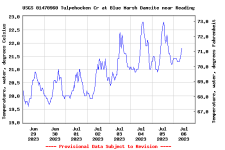If it was “freezing cold” it was in the early 1980’s when we were trying to figure out how to most effectively manage the water temps with the limited volume of cold water that was available. It was either 1981 or 1982 when we first ran cold water without mixing for as long as we could into the summer. It was cold, but didn’t last very long. Then the next year we had the ACOE mix cold water with near-surface water once the tailrace reached a warmer target temp (might have been a target of 60 or 62 deg…somewhere in that neighborhood). Again, the tailrace was cold, but the cold water was short-lived. Finally, the third year’s try was the charm, such as it was, when we started the mixing process when the tailrace hit 68 degrees at 8 AM three days in a row. That was the best set-up to make cool temps last the longest and not have max temps get exceptionally high, although certainly stressful, during the period when mixing was possible. It’s been run that way ever since. Note, however, that 68 is the start of the stressful temperature zone for RT and BT. We had to put the fish into some stress on almost a daily basis once the first week of June (usually) occurred just to carry the fishery part way through the summer. It remains to be seen ifmthe Cacoosing situation will extend the fishery longer, at least for a kilometer or so downstream from its confluence.




